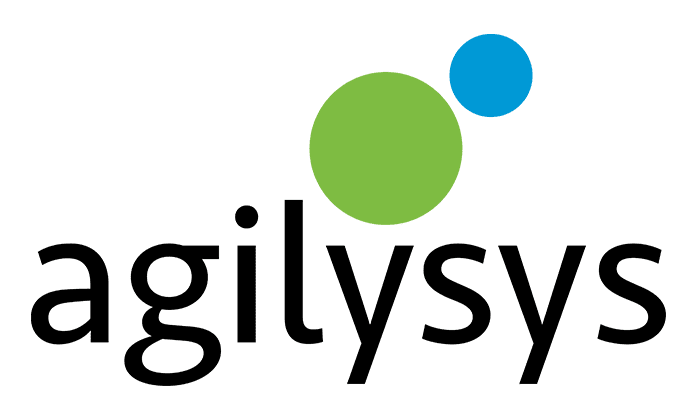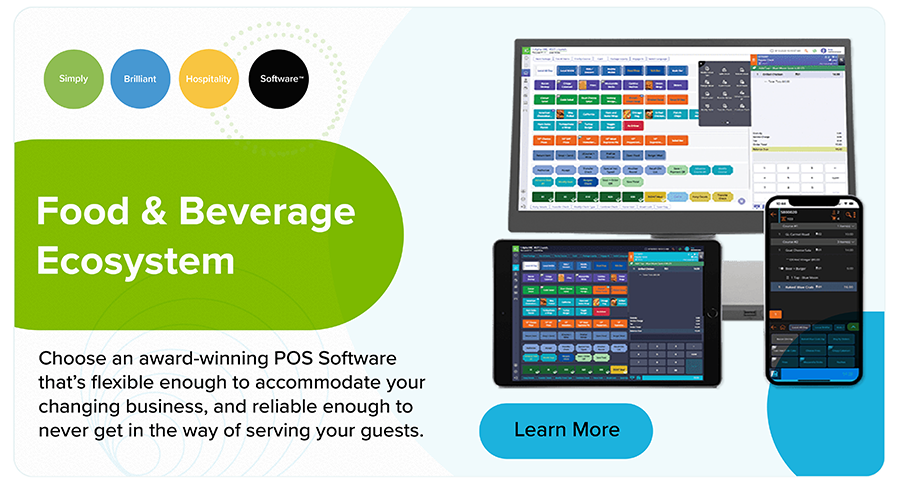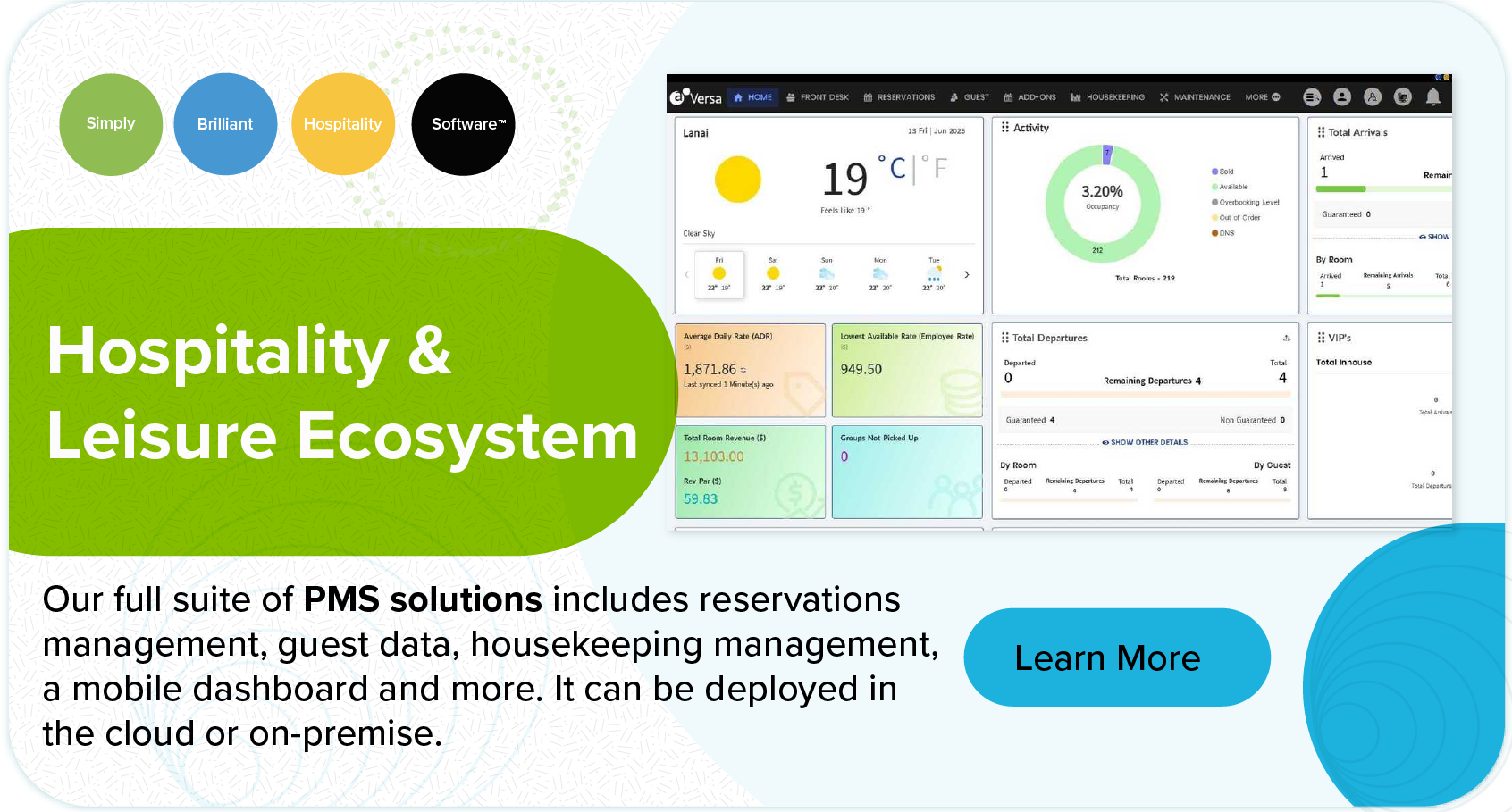
- Solutions
- Food & Beverage Ecosystem
Food & Beverage Ecosystem
Optimizing food & beverage operations and profitability demands a flexible, enterprise-class point-of-sale system. Is yours up to the task?
Go- Hospitality & Leisure Ecosystem
Hospitality & Leisure Ecosystem
From an individual location to an enterprise chain, get the most modern, mobile solution for managing your hospitality business
Go
- Inventory & Procurement Ecosystem
Inventory & Procurement Ecosystem
Designed to optimize foodservice and retail inventory and procurement operations for hotels, resorts, universities, restaurants and others.
Go
- Professional Services
Professional Services
Hospitality businesses are global, 24/7 operations with complex technology demands. You don’t have to go it alone.
Go
- Solution Studios
- Hotels
Hotels
Whether you operate a single boutique location or a large hotel chain, there’s an Agilysys hotel solution for you.
Go- Resorts
Resorts
Whether you operate a single boutique location or a large complex resort, your property is a unique operation that requires robust solutions supported by an experienced technology partner
Go
- Casinos
Casinos
You’re more than a gaming operation. You’re a full-service casino resort property and success isn’t about playing the odds, it’s about making the most of every revenue opportunity.
Go
- Tribal Gaming
Tribal Gaming
A leader in casino hospitality management solutions who respects the sovereignty of your nation.
Go
- Cruise Lines
Cruise Lines
Smooth seas ahead: technology solutions from Agilysys, a leader in cruise management systems.
Go
- Higher Education
- Corporate Dining
Corporate Dining
Identify emerging dining trends while aligning coverage with demand and capturing more revenue.
Go
- Healthcare
Healthcare
Delight patients & visitors, retain staff and grow margins with a suite of hospitality solutions for healthcare environments.
Go
- Life Plan Communities
- Foodservice Management
Foodservice Management
End-to-end foodservice management software solutions for optimum productivity and profitability.
Go
- Stadiums
- Restaurants
- Airports
Airports
Optimizing dozens of food & beverage outlets throughout your facility demands world-class POS performance combined with real-time operating insights.
Go
- Resorts
- Resources
- Articles
Articles
Access our library and read about the latest in emerging technology and other hospitality trends. Find tips and insights on accelerating business growth and improving guest satisfaction.
Go- Customer Stories
Customer Stories
Learn why so many businesses, small and large, partner with Agilysys for their hospitality technology needs.
Go
- Customer Videos
Customer Videos
Watch and learn what Agilysys customers have to say about their experiences with our solutions.
Go
- Product Resources
Product Resources
An in-depth collection of product information and datasheets. Read about the latest in hospitality technology features designed to solve the challenges faced by hospitality professionals around the globe.
Go
- Product Showcase
Product Showcase
Hear from industry professionals about the latest advancements, including tips and tricks, in hospitality and emerging technologies. Check out the library of demo videos and webinar recordings.
Go
- Webinars
Webinars
Watch and learn about the latest in successful technology trends and hear from hospitality professionals in this selection of interactive videos.
Go
- Industry Reports
Industry Reports
Important research and studies from across the hospitality industry. Find out what thought leaders are saying.
Go
- Customer Stories
- Company
- Leadership
- Solution Partners
Solution Partners
Agilysys has a broad collection of partners and APIs to help you assemble the perfect solution for you.
Go
- Our Customers
Our Customers
Discover how Agilysys customers like you are using our solutions to improve their business and guest experience.
Go
- Investor Relations
- News
- Events
Events
With the Agilysys commitment to 100% Hospitality solutions, we take industry events and conferences seriously. Please see where you can find Agilysys to learn more.
Go
- Career
- FAQS
FAQS
Go
- Solution Partners
- Support
- Contact Support
- Microsoft Patch Testing
Microsoft Patch Testing
See what Microsoft products and versions are currently support by Agilysys.
Go
- Payment Center
- RMA Requests
- Supply Order
Supply Order
Go
- Hospitality IQ
Hospitality IQ
Go
- Knowledge Center
Knowledge Center
Go
- Microsoft Patch Testing
- Blogs
- MyAgilysys
-
 Get a Demo
Get a Demo 877 369 6208
877 369 6208
×Home
☰- Explore
WHAT'S THE BUZZ IN HOSPITALITY?
How to Integrate a New PMS Without Disrupting Operations
Upgrade Your Property Management System Smoothly, Without Losing Sleep-or Guests.
Why Is Switching PMS So Stressful?
Changing your Property Management System (PMS) is a major move. While the long-term benefits—better functionality, happier staff, improved guest experiences—are obvious, the short-term disruption can feel intimidating.
What if the new system doesn’t sync?
What if staff don’t adapt quickly?
What if guests notice the hiccups?The good news? With the right planning and partnership, you can implement a new PMS without disrupting daily operations or compromising guest service. Let’s break it down.
What Are the Most Common Pain Points During a PMS Transition?
Before we dive into solutions, it’s important to recognize the most common challenges properties face when replacing their PMS:
- Data migration issues (incomplete or incorrect guest histories)
- Staff resistance or slow adoption
- Downtime during peak operating hours
- Loss of reservations or booking inaccuracies
- Integration breakdowns with POS, CRM, or housekeeping systems
- Training gaps that lead to operational errors
Understanding these risks is the first step to preventing them.

Step 1: Why Planning Is Everything
A successful PMS transition starts well before the new system goes live. Thorough planning reduces chaos and ensures everyone—from IT to the front desk—is on the same page.
Here’s what to prioritize:
- Timeline planning: Avoid peak seasons; choose a quieter period
- Phased rollout: Test functionality in stages if possible
- Stakeholder alignment: Get early buy-in from operations, marketing, finance, and front-line teams
- Data prep: Clean and verify guest and booking data before migration
- System mapping: Ensure the new PMS integrates with all existing systems (POS, CRM, channel managers, etc.)
Step 2: How to Train Your Staff Without Overwhelming Them
Technology is only as effective as the people using it. PMS transitions succeed when staff feel confident—not confused.
Tips for effective training:
- Use role-based training: Customize sessions for front desk, housekeeping, accounting, etc.
- Offer both in-person and digital formats: Cater to different learning styles
- Provide sandbox environments: Let staff practice before going live
- Designate “super users”: These are internal champions who can help others troubleshoot
- Keep the training ongoing: Offer refreshers and on-demand resources post-launch
When your team is ready, your operation will be too.
Step 3: How to Avoid Guest Disruption
Guests shouldn’t feel the shift behind the scenes—and they won’t if you plan smartly.
Key ways to avoid disruption:
- Avoid system switchovers during high check-in/check-out windows
- Use dual systems briefly (if needed) to confirm accuracy during the cutover
- Test the booking engine and mobile guest tools thoroughly
- Ensure reservation confirmations are still delivered accurately
- Have a backup process (manual check-in, printed folios) on standby just in case
Guests will remember how smoothly their stay went—not whether your tech changed mid-visit.
Step 4: How to Ensure Your Data Makes the Move Safely
Data migration is one of the most critical steps—and also one of the most underestimated.
Don’t just migrate everything blindly. Take time to:
- Clean your guest data: Remove duplicates, outdated info, or irrelevant records
- Tag high-value guests and VIPs for custom mapping
- Migrate only what you need: Focus on recent history and loyalty data
- Test the data in a live environment before full cutover
- Encrypt sensitive data and ensure compliance with data privacy regulations
Ask your PMS partner for detailed migration protocols—and demand transparency.

Step 5: Why the Right Technology Partner Makes All the Difference
A seamless PMS integration isn’t just about the product—it’s about the people behind it.
Choose a vendor that:
- Offers end-to-end onboarding and implementation support
- Provides dedicated account managers and trainers
- Has a proven history of successful PMS rollouts
- Offers 24/7 support, especially in the first 90 days post-launch
- Understands hospitality, not just software
The best PMS providers act as a partner, not just a vendor—walking with you every step of the way.
Key Takeaways
- PMS transitions are high-stakes—but with the right planning, they can be smooth and strategic.
- Start with a clear implementation plan, including data prep, system mapping, and stakeholder alignment.
- Train staff with hands-on, role-specific support, and identify internal champions.
- Test extensively and ensure backup processes are in place to avoid guest-facing issues.
- Work with a PMS partner that understands your business and offers hands-on guidance.
Ready to upgrade your PMS without missing a beat?
Agilysys helps properties Go Beyond with expert-led implementation, real-time support, and integrated platforms that connect operations, staff, and guests.
2026 Hospitality Industry Conferences You Shouldn't Miss
Read More
The 2025 Global Hospitality Study
Download Study
The Guest Economy: Top 5 Hospitality Technology Predictions for 2026
Learn MoreCategories
- Contact Support
- Leadership
- Articles
- Hotels
- Food & Beverage Ecosystem




